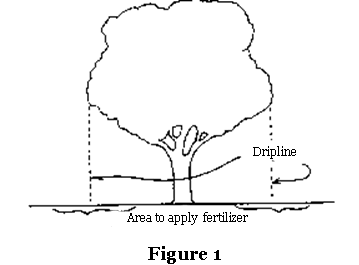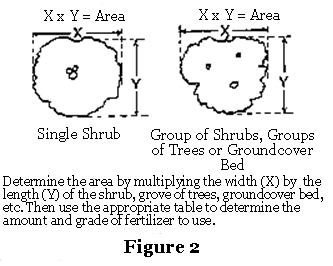Properly fertilized plants are more likely to survive a stress period (drought, severe winter, and insect or disease attack) than plants grown in soil with inadequate nutrient levels. Fertilizer, however, will not overcome poor cultural conditions such as inadequate light, water logged, compacted or droughty soil, poor plant selection, air pollution, misuse of pesticides, etc.
Always have your soil tested before applying fertilizer. See the UConn Soil Nutrient Analysis Laboratory for information.
When to Apply Fertilizer
Fall (late September through mid-October) is the preferred time to fertilize woody plants (trees, shrubs, vines and groundcovers). Early spring, before growth starts, is the next best time. Fertilizing from July through September should be avoided unless the plant is under severe stress due to a nutrient deficiency. The new growth that results from fertilizing during this period often does not harden before the onset of winter, and the result is tip dieback of the new growth.
How Much Fertilizer to Apply
The fertilizer recommendations in the table show varying ranges of fertilizer to apply. The smaller amount in a given range should supply enough nutrients for maintenance and adequate growth. The larger amount in a given range will result in more growth. This may be desirable for plants that have not reached the desired or mature size. The larger amount is undesirable if the plant has reached sufficient size. Flowering trees and shrubs (crabapple, dogwood, rhododendron, etc.) should receive the smaller amount of fertilizer in a range to avoid lush vegetative growth at the expense of flower bud formation. Flower bud formation is essential if flowering is to occur the following season.
The Fertilizer Bag Label
All bags of fertilizer have a series of three numbers called the fertilizer grade, which lists the percentage of nitrogen as N, phosphorus as P and potassium as K. For example, a 50 lb. bag of 10-6-4 would contain five lbs. of N, three lbs. of P and two lbs. of K.
Substituting Fertilizers
It is possible to substitute a fertilizer of one grade for that of another grade. For example, 10-20-20 can be used in place of 5-10-10. An important adjustment must be made, however. The 10-20-20 contains twice as much N, P and K as 5-10-10. Therefore, 10-20-20 should be applied at half the rate suggested for 5-10-10.
Weight of Fertilizer
The following table provides fertilizer recommendations in pounds. Fertilizer is available in 80, 50, 20, 10 and 5 lb. bags. To estimate small or intermediate amounts of fertilizer, the following fact is helpful: one level unpacked cupful of 10-10-10, 10-6-4, 5-10-10 or 5-10-5 weighs approximately 1/2 pound.
| Formulation | Deciduous Trees, Shrubs, Groundcovers & Vines |
Evergreen Trees, and Shrubs; Narrow-leaf Evergreens, Rhododendrons and Azaleas |
| Lbs. of Fertilizer per 100 sq. ft. | Fertilizer* | |
| 10-6-4 or 10-10-10 | 1-2 | 1/2-1 |
| 5-10-10 | 2-4 | 1-2 |
| 5-10-5 | 2-4 | 1-2 |
*Use the amount recomended or the equivalent from other sources.
Application Notes
Where the tree or shrub has overgrown a walk, a driveway, rock outcropping or other barrier or structure; reduce the amount of fertilizer applied in proportion to the area covered by the walk, etc. Do not use fertilizer containing broadleaf weed killers (herbicides) near or under woody plants.
Tree Fertilization
Traditionally, trees in the landscape were fertilized by placing the fertilizer in holes that were drilled or punched into the ground. The reason was to place the fertilizer below the competing grass roots. Recent research has shown that most of the tree’s roots are in the upper six to twelve inches of soil. Therefore, the fertilizer placed in holes was below much of the root system. Also, the distribution of the fertilizer was poor because of the limited root contact with the fertilizer.
The root system of a tree can spread one and one half to two times its height. For example, a tree with a height of 40 feet could have a root spread of 60 to 80 feet. This means the roots will spread 30 to 40 feet away from the trunk. This puts a large percentage of the fine feeder roots well beyond the drip line, which traditionally has been the location of fertilizer added by the hole method.
Concentrated areas of fertilizer will burn the roots while leaving lager areas unfertilized.
The use of solid sticks of fertilizers that are pounded into the ground has the same disadvantage as fertilizer placed in holes-there is limited root contact. An improvement of the hole method is to pump a fertilizer solution into the ground using a feeding needle. The pressures in use improve the dispersal of the fertilizer. However, the fertilizer material is often placed twelve or more inches below the surface. An advantage to this method is the loosening of compacted soils.
The preferred method of fertilizing is to spread the fertilizer on the surface over the entire root system of the plant. This allows more of the root system to pick up the nutrients and eliminates zones of high fertilizer concentration which can damage the tender feeder roots. Trees planted in regularly fertilized lawns will probably not require additional fertilizer. See Figures 1 and 2.
Shrub Fertilization
The root system of most shrubs is located in the area under the plant and extends a few feet beyond the spread of the branches. Therefore, the fertilizer should be broadcast in this area. Avoid injury to the plant by keeping the fertilizer a few inches from the stem. The amount of fertilizer to apply is calculated from the table after measuring the area covered by the plants. See Figures 1 and 2.


Ericaceous Plants
The ericaceous plants (rhododendron, azalea, laurel, pieris, andromeda, etc.) are shallow, fibrous-rooted plants that can be damaged by heavy applications of fertilizer. Apply only the lower rates of fertilizer for plants of this group. An important cultural practice that is often neglected for this group of plants is maintaining the soil’s organic matter content. This is easily accomplished by adding an inch or two of organic mulch every year or so. If the mulch is a composted material, which contains some manure, it will not be necessary to apply any additional fertilizer.
Groundcovers
Determine the area of the groundcover bed. Broadcast the amount of fertilizer evenly over the area. Apply the fertilizer when the foliage is dry to prevent injury. Fertilizer sticking to wet foliage can cause "burning", and it should be brushed or hosed off.
Vines
A vine will "travel" a long distance from where it was planted alongside a wall or under a trellis. The roots radiate in all directions from the point where the stem emerges from the ground unless the vine is planted against a building or some structure that restricts the growth of the roots. Stay at least one foot away from the stem when broadcasting the fertilizer. Cover an area at least 10 ft. x 10 ft. (100 sq. ft.) around the stem. If the ground is bare or planted with shrubs, scratch the fertilizer into the soil to a depth of 1/2 to 1 inch. Vines growing in or near a regularly fertilized lawn will probably not require additional fertilizer.
Watering After Fertilizing
Ideally, fertilizer should be applied just before a heavy rain is predicted so that the fertilizer will wash into the soil. Irrigate the fertilizer area with about 1/2 to 1 inch of water if no rain or only a shower is forecast. Measure the amount of water being applied by placing several tuna-size cans across the sprinkler pattern. It normally takes one to two hours to deliver one inch of water.
For pesticide information or other questions please call toll free: 877-486-6271.
Revised by UConn Home and Garden Education Center 2016.